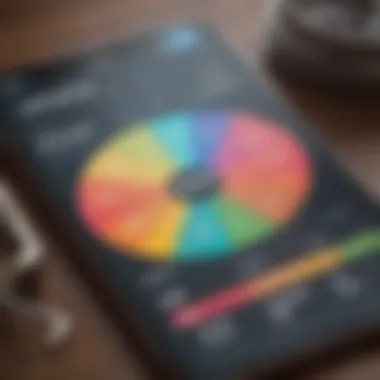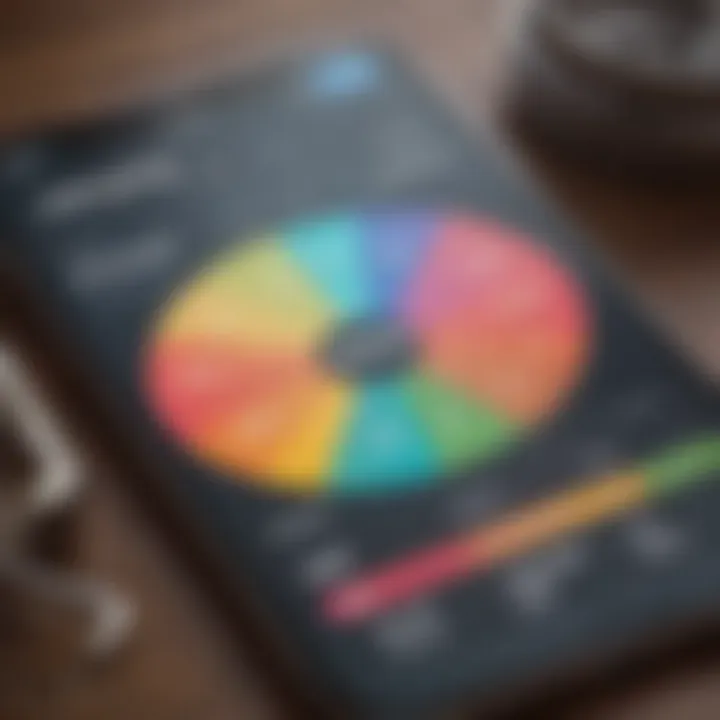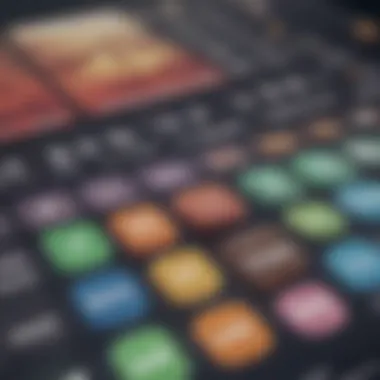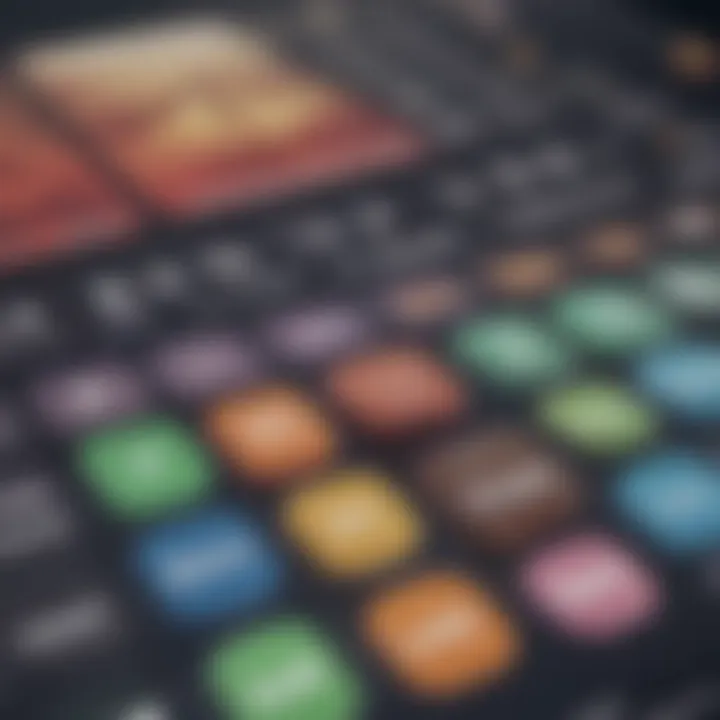Top Personal Budgeting Apps for iPhone Users Reviewed


Intro
Navigating the world of personal finance can often feel like swimming against the tide. With a plethora of choices available ranging from securing investments to managing day-to-day expenses, having the right tools can significantly lighten the load. Among these tools, budgeting apps stand out, particularly for iPhone users who want to wield the power of technology in tracking and managing their finances effectively.
Budgeting apps not only tally what goes in and out but can also give valuable insights into spending habits. This is crucial because it sets the stage for sound financial decision-making. Understanding your financial landscape can make a world of difference, and that's where technology comes in handy. Whether saving for a special project or simply aiming to reign in spending, the right app can pave the way.
The range of available applications varies widely in functionality, design, and user experience. This article sets out to explore the essential aspects of personal budget apps for the discerning iPhone user. By the time you finish reading, you'll not only comprehend the features that matter but will also know how to leverage these apps to take control of your financial destiny.
Prelude to Personal Budget Apps
In today’s fast-paced world, managing finances has become as essential as knowing how to drive a car or cook a meal. When it comes specifically to iPhone users, personal budget apps have become a critical tool in ensuring financial stability. This section explores the significance of budgeting software in a digital age driven by technology.
Budgeting apps not only help users track their expenses but also foster better spending habits. With daily expenses getting higher and the need for savings becoming more pronounced, individuals often feel like they are riding a roller coaster, emotionally fluctuating between anxiety and relief when it comes to money management. Apps simplify this process, allowing users to easily visualize where their money goes while keeping their financial goals in sight.
Understanding the Need for Budgeting
Understanding why budgeting is crucial can be likened to knowing how to breathe; both are vital for living well. Many people struggle with proper money management, often finding themselves in a cycle of overspending. By establishing a solid budget, users can prioritize their needs over their wants — and this is where budgeting apps come into play. They serve as a guiding light.
For instance, imagine trying to navigate through a dense forest without a map. Budgeting apps act as that indispensable map, guiding users to identify wasteful spending habits, categorizing expenses, and establishing savings goals. This not only increases awareness about financial health but also encourages users to become more disciplined in their day-to-day choices. It’s all about attaining a sense of control over one’s finances.
Rejecting the notion that budgeting is a chore, these apps make the process engaging and interactive. They can nudge users back on track when they veer from their financial paths, providing gentle reminders or insights that make a significant difference in achieving their desired outcomes.
The Evolution of Budgeting Technology
Budgeting technology has come a long way from the rudimentary spreadsheets of yesteryears. If we take a stroll down memory lane, we can witness the transformation from manual record-keeping with pen and paper to sophisticated digital platforms. Back in the day, managing finances involved meticulous calculations and headaches from balancing accounts. Now, technologies like cloud computing and mobile applications have revolutionized how individuals monitor their spending and savings.
Today’s budgeting apps come with features that were once merely dreams. First and foremost, they allow for real-time expense tracking. Users can snap a photo of their receipts and see the money spent in an instant. Furthermore, integration with bank accounts streamlines the process by automatically syncing transactions, taking the labor out of managing finances.
"The best budgeting apps have evolved from simple calculators to comprehensive financial management tools that take proactive measures to help you achieve your goals.”
Additionally, as the technological landscape continues to advance, we see the infusion of elements like artificial intelligence being integrated into these applications. Such advancements suggest that the future holds even more potential, making budgeting easier and more intuitive as these tools learn from user habits and preferences. Overall, this evolution signifies more than just convenience; it denotes a cultural shift toward prioritizing financial literacy and awareness among users, positioning them to be more proactive rather than reactive about their finances.
Criteria for Selecting a Budget App
Choosing the right personal budget app is not merely a matter of preference; it can have profound implications on how individuals manage their finances. This section highlights critical elements to consider when evaluating potential budget apps.
First, user-friendliness plays a pivotal role. An app that is intuitive and easy to navigate can make the difference between consistent use and an abandoned project. If users feel overwhelmed by a complicated interface, the app might do more harm than good.
Second, features are not just bells and whistles; they have a direct impact on a user's budgeting experience. A well-rounded app should include effective expense tracking, goal-setting tools, and comprehensive reporting structures. These functionalities empower individuals to take charge of their financial journeys.
Next, we can’t overlook data security and privacy measures. In a time when personal information can be a hot commodity, budget apps must assure users that their financial data is in safe hands. This peace of mind can’t be taken lightly.
Finally, cost considerations are crucial as many apps come with varying subscription models. Finding an app that delivers value for money can ensure that budgeting remains a sustainable habit rather than a sporadic endeavor.
In summary, the criteria for selecting a budget app encompass aspects that are vital for effective financial management. Keeping the focus on usability, feature-rich environments, security, and affordability can significantly elevate the budgeting experience.
User-Friendliness and Interface Design
Simplicity is key. An app that's easy to use not only saves time but also encourages regular engagement. Think of it as creating a welcoming environment for your finances. If the design feels clunky or the navigation is a head-scratcher, users might find themselves abandoning their budgeting journey.
Good user interface (UI) design culminates in a smooth experience. Icons should be intuitively placed, and steps to input information should not resemble solving a Rubik's Cube. Also, responsive design ensures the app works well across various iPhone models, enhancing accessibility.
Features and Functionality Overview
In the realm of budgeting apps, features are paramount. They can define whether the app becomes a trusty financial companion or just another icon on your home screen. Below are crucial aspects to consider:
Expense Tracking
Expense tracking is the backbone of any budget app. It allows users to categorize payments and visualize spending habits. The ability to see where money is going can lead to informed decisions about future expenditures.
A key characteristic of effective expense tracking is its ability to sync with bank accounts or allow manual entry. While automation offers convenience, some users prefer manual input to stay connected with their spending.
One unique benefit of expense tracking is the predictive analytics that many apps offer, helping users anticipate future expenses based on past behavior. However, a downside could be the initial time investment required to input and categorize expenses effectively.
Financial Goal Setting
Goal setting within budgeting apps can significantly bolster financial discipline. By defining clear objectives, users can turn abstract aspirations into achievable targets. This feature provides motivation and a pathway towards saving for a vacation or paying down debt.
One of the appealing traits of financial goal setting is its visual progress indicators. These present a tangible sense of accomplishment as users inch closer to their targets. On the flip side, some might find the feature overwhelming if the goals set are unrealistic.


Reporting Tools
Effective reporting tools provide insights that transcend mere numbers. They enable users to generate a variety of reports, from monthly spending summaries to category-specific breakdowns. These insights can be the awakening that prompts necessary changes in spending habits.
A standout feature often found in robust reporting tools is customizable reports. Users can tailor the data to focus on specific areas of their budget, making the information more relevant to their particular financial situation. Yet, a potential drawback is that too much data at once may lead to confusion rather than clarity.
Data Security and Privacy Measures
In an era rife with data breaches, security has taken center stage in app selection. Users must prioritize apps that prioritize safeguarding personal information. Strong encryption methods are non-negotiable, as are transparent privacy policies.
Many budget apps have begun employing two-factor authentication (2FA) as an added layer of security. This process, while slightly cumbersome, offers peace of mind that unauthorized access is less likely.
Cost and Subscription Models
Budget apps come with a mixed bag of pricing structures. Understanding these can help navigate what's reasonable and what's highway robbery. Many offer free versions with basic features. But operators often hope that attractive upselling will encourage users to transition to premium versions.
The beauty of a subscription model often lies in providing ongoing updates and support. However, it's essential to consider the cumulative cost over time. Users should calculate whether the benefits of subscription justify the expense and fit their financial obligations.
With these layers of understanding, users can approach personal budgeting with the clarity and confidence that the right app can provide.
Top Rated Personal Budget Apps for iPhone
In the vast universe of personal finance tools, the importance of identifying top-rated budgeting apps for iPhone users cannot be overstated. Today, many individuals are seeking smarter ways to manage their finances right from the palm of their hands. There is a sea of applications designed to help users track their expenses, set financial goals, and even achieve substantial savings. Therefore, choosing the right application becomes paramount for anyone looking to simplify their budgeting journey.
When we talk about top-rated budgeting apps, the conversation forks into several critical areas: user experience, robust features, and data security. Without a doubt, these are crucial elements that can enhance or detract from one's budgeting experience. Moreover, with the capability of connecting to banks and investment platforms, innovative budget apps allow users to have a 360-degree view of their financial health.
"A good budget app is like a trusty compass. It guides your spending, keeps you grounded, and ensures you don't stray too far from your financial path."
As we delve into this section, we will review three standout apps that have caught the attention of both casual spenders and serious savers alike. Each app comes with its unique flair, addressing various needs and preferences. Let’s explore the features and benefits that make them favorites among users.
Review of App One: Features and Benefits
First off, let’s take a closer look at YNAB (You Need A Budget). This app has made quite a name for itself, especially among those who prioritize proactive financial management.
Features include:
- Goal-Based Budgeting: Users can allocate funds to specific categories based on their financial goals, promoting a more intentional spending approach.
- Real-Time Updates: The app allows synchronization with bank accounts, providing a live feed of transactions, so budgeting feels spontaneous and organic.
- Educational Resources: YNAB offers extensive tutorials and workshops, helping users understand budgeting principles and strategies deeply.
The benefits of YNAB lie in its ambitious mission: to help users break the paycheck-to-paycheck cycle and encourage a more thoughtful financial lifestyle. However, it’s worth noting that a yearly subscription fee might not sit well with everyone.
Review of App Two: Features and Benefits
Next, we turn our sights towards Mint. This app is often recognized for its user-friendly interface and detailed insights.
Key Features:
- All-in-One Financial Overview: Mint aggregates all your financial accounts in one place, presenting a centralized view of income, expenses, credit scores, and more.
- Budgeting Alerts: It notifies users when they're nearing their spending limits, encouraging adherence to budgets and minimizing overspending.
- Easy Bill Tracking: Mint allows users to track bills directly within the app, helping to prevent late payments.
Mint's appeal lies in its free usage model, funded by advertisements and offers, which certainly broadens accessibility. This makes it particularly attractive for students and new graduates just starting their financial journeys.
Review of App Three: Features and Benefits
Lastly, we have PocketGuard, an app designed to simplify the budgeting process for those who feel overwhelmed by numbers.
Features of PocketGuard include:
- In-Pocket Calculation: This feature helps users understand how much money they have left to spend after accounting for bills, goals, and necessities, making budgeting less daunting.
- Bank Account Connectivity: Just like others, PocketGuard connects to your bank accounts, ensuring a real-time budget status without manual entry.
- Spending Categories: The app categorizes spending for users, making it easier to grasp where the money goes each month, thus promoting self-awareness in spending habits.
The notable benefit of PocketGuard is its ease of use, which removes the complexities often associated with personal finance apps. This makes it a solid choice for users who seek straightforward budgeting without the bells and whistles.
Comparative Analysis of Budgeting Apps
The comparative analysis of budgeting apps serves as a critical component of this article. It enables users to slice through the noise and hone in on which applications truly meet their financial management needs. By contrasting the key features, performance, and user experiences of several budgeting apps, readers can gain a clearer perspective on their options. This informed approach is particularly beneficial in today's saturated app market, ensuring that choices are based on functionality and not merely on marketing hype.
In particular, the importance of this analysis lies in several core elements:
- Objective Assessment: Comparing budgeting tools allows for an unbiased look at what each app excels in and where it may fall short. This is essential for users who want to maximize their financial health without getting sidetracked by sleazy advertising or unverified reviews.
- Feature Differentiation: Different budgeting apps come with diverse sets of features. Some may offer robust reporting tools while others shine in user experience. Understanding these contrasts helps users determine which aspects matter most—be it integration, ease of use, or a range of functionalities.
- Informed Decision-Making: With an understanding of how various apps stack up against each other, users can make educated choices that align with their financial goals. By identifying the app that suits personal habits and preferences, users can turn budgeting from a chore into an empowering aspect of financial well-being.
Feature Comparison Matrix


A feature comparison matrix effectively lays out the distinguishing characteristics of popular budget apps side by side, allowing for easier memory retention and analysis. In this structured format, users can quickly identify which apps meet their specific criteria. Aspects one might include in such a matrix are:
- Expense Tracking: How seamless is the tracking of daily spending?
- Syncing Options: Does the app connect easily to bank accounts and investment platforms?
- User Interface: Is it intuitive? How does it compare with other apps?
- Reporting Tools: What kind of insights can the user gain from the data?
- Security Features: How effectively does the app protect user information?
Here’s an example of how a comparison might look in a simple table format:
| Feature | App One | App Two | App Three | | Expense Tracking | Yes | Yes | No | | Syncing Options | Excellent | Good | Fair | | User Interface | Very Intuitive| Standard | Simple | | Reporting Tools | Advanced | Basic | Comprehensive | | Security Features | High | Medium | High |
User Feedback and Reviews
User feedback offers keen insights that can’t be captured solely by features or expert analysis. It reflects the real-world application of budgeting apps and highlights common praises and pain points. Gathering reviews from users can help to inform potential users about how these apps perform in day-to-day life.
- Common Themes: Trends often emerge in user reviews that signify strengths or weaknesses of an app. For example, an app might receive accolades for its smooth integration with bank accounts but faces critiques for slow response times when issues arise.
- Stars and Ratings: Analyzing ratings on platforms such as Reddit or app stores reveals overall sentiment and can influence new users’ perceptions.
"User experience can often reveal the usability of an app more than its feature list ever could. Taking heed of user feedback can inform better choices for personal financial management."
- Diverse Perspectives: Each user brings unique perspectives based on their financial situations and habits. Some may prioritize budgeting for groceries, while others focus on long-term savings, and these differences shape how they perceive an app's utility.
Integration with Financial Services
In today’s financial landscape, integrating personal budget apps with various financial services is crucial for achieving a streamlined and comprehensive financial management experience. For iPhone users navigating this digital world, integration is not just a convenient feature; it’s a game-changing necessity. It allows users to garner real-time insights into their financial health without the tediousness of manual data entry. When apps connect seamlessly to users’ bank and investment accounts, they create a single source of truth, minimizing discrepancies and enhancing transparency.
The benefits of integration with financial services can be significant. By allowing apps to pull in data from multiple sources, users can view their entire financial picture at a glance. This convenience can also aid in better decision-making by identifying spending habits or savings opportunities that may not be apparent otherwise. In addition, seamless connections can help keep track of spending limits, commitments, and even reminders for upcoming bills, encouraging better money habits overall.
However, there are some considerations that users should keep in mind. While integration offers numerous advantages, it necessitates trust. Users must consider the security of sensitive information, as financial data can be a target for breaches. Thus, one must opt for apps that prioritize data encryption and have robust privacy policies in place. It's not just thinking of today; it's about ensuring that your financial data remains safe in the long run.
“Seamless integration can transform the way individuals understand their finances—it’s like having a personal financial advisor in your pocket.”
Connecting to Bank Accounts
Connecting personal budget apps to bank accounts is a vital step in utilizing these tools effectively. This connection enables apps to import transaction data automatically, allowing users to track their spending in real time without inputting data manually.
Key advantages include:
- Time savings: Users no longer need to spend hours entering transactions, making budgeting less burdensome.
- Accuracy: Automated data entry reduces human error, helping to ensure that financial records reflect actual spending.
- Real-time updates: Users receive instant updates on their financial situation, which can alert them to overspending or unanticipated charges.
When setting up this connection, it’s essential to choose an app that utilizes a secure connection method, often through bank-level encryption standards. Users should also review permissions the app requests and understand how their data will be used before finalizing the link to avoid any unwelcome surprises.
Syncing with Investment Platforms
Another dimension of integration involves linking budgeting apps with investment platforms. This capability allows users to not only monitor their expenses but also to understand how their investments affect their overall financial health.
By syncing with platforms like Vanguard or Robinhood, budget apps give clarity on:
- Portfolio performance: Users can track both gains and losses, leading to informed decisions about purchasing or reallocating assets.
- Impact of investment on cash flow: Understanding how investments align with current expenses can guide users in assessing their risk tolerance and required cash reserves.
- Holistic financial planning: Users can create budgets that accommodate investment goals, facilitating savings specifically earmarked for investing or retirement.
In the end, the integration with financial services is about harnessing the full potential of technology. It’s about turning numbers into actionable insights, guiding users to make smarter financial decisions. The ongoing evolution of personal budgeting apps promises more sophisticated integrations, hinting at a future where financial management becomes second nature.
Noteworthy Trends in Budgeting Apps
Budgeting apps, just like the world around us, aren’t sitting still. They are adapting and changing to meet the demands of an increasingly tech-savvy audience. Understanding these trends can aid users in making informed choices that push their financial literacy forward. In this section, we will dive into two prominent trends that are reshaping how personal finance management is experienced on iPhones: Artificial Intelligence (AI) and the mobile-first approach to financial management.
Artificial Intelligence in Budgeting
Artificial Intelligence is making waves in various industries, and personal finance management is no exception. One noteworthy aspect of AI in budgeting apps is its ability to analyze spending patterns. These apps can sift through heaps of transaction data, identifying trends and offering tailored suggestions.
For instance, rather than just displaying a user’s spending on groceries, an AI-equipped app might suggest, “You typically spend $150 on groceries each month. Consider reducing it by 10%.” This kind of proactive guidance can help users understand their habits better and encourage them to make intentional decisions.
Several budgeting apps now use machine learning algorithms to adapt to individual user behaviors. Over time, these apps learn how to predict future spending, which can be extremely advantageous for budgeting. They can provide insights into when users are likely to overspend, prompting them to adjust before it becomes a problem.
"AI is not just a tool; it's a partner in your financial journey, helping steer the ship as you navigate through your spending waters."
Moreover, AI’s capability to automate repetitive tasks can’t be understated. By setting reminders for bill payments or sending alerts for unusual transactions, users can minimize the risk of late fees or fraud. In short, this trend enhances efficiency and user experience, making budgeting less of a chore and more of a seamless process.
Mobile-First Financial Management
As we live increasingly on our phones, the mobile-first financial management approach has emerged as a significant trend among budgeting apps. This means that developers are prioritizing the design and functionality of apps for mobile devices, embracing the notion that users want financial tools at their fingertips – literally.
Budgeting apps are now incorporating features that take full advantage of the iPhone’s capabilities, such as biometric authentication for security, GPS for location-based spending reports, and push notifications for real-time updates. Users can quickly get insights into their financial situations with just a few taps.


Things are also changing on the interface front. Developers are placing a premium on intuitive, easy-to-navigate interfaces, ensuring users can find what they need without diving into layers of menus. Swiping, tapping, and even voice commands are being integrated to create a more user-friendly experience.
Lists of transactions, budgeting categories, and financial goals are designed to be visually attractive, engaging users from the get-go. The result? A more enjoyable and effective budgeting journey. Furthermore, the flexibility that comes with mobile-first management allows users to make adjustments on the fly. If someone has an impromptu dinner with friends, they can quickly log that expense, view its impact on their budget, and adjust as needed.
Challenges in Personal Budgeting
Personal budgeting is no walk in the park, especially when one considers the complexities of modern financial life. The digital era has brought a plethora of tools, yet it hasn’t entirely alleviated the struggles individuals face in managing their finances effectively. Understanding these challenges is vital for comprehending the efficacy and utility of personal budget apps designed for iPhone users.
Common Pitfalls in Budgeting Apps
Despite the technological advancements, many budgeting apps suffer from a range of drawbacks that can lead to user frustration and inadequate financial management. Here are a few common pitfalls:
- Overcomplicating the process: Some apps create a labyrinth of features that can overwhelm users, leading to decision fatigue. When users feel lost inside an app, they are less likely to engage with it regularly.
- Limited customization: A budgeting app that does not allow users to tailor it to their specific financial needs can feel restrictive and may not effectively help in tracking personal expenses. Each individual has diverse income sources and spending habits; one-size-fits-all solutions can fall flat.
- Poor integration with financial institutions: Users often expect seamless connectivity with their banks. If an app struggles with integrations, it can create a barrier to accurate tracking, requiring manual updates that most will not commit to.
- Insufficient reporting tools: The best budgeting practices stem from analyzing trends over time. Apps lacking in robust reporting functions can leave users in the dark about their financial habits.
Navigating these pitfalls is necessary for users to derive maximum benefit from their chosen budgeting app. If one app fails to address these issues, users may abandon it for another, leading to a cycle of frustration and detachment from their financial goals.
User Resistance to Change
Changing financial habits is often a tall order. Users might find themselves clinging to old methods, resisting the shift to a digital budgeting tool. This resistance can stem from various sources:
- Fear of technology: For some, the complexities of new apps might induce anxiety. Not everyone is tech-savvy, and the fear of making mistakes while learning a new system can deter users from fully engaging.
- Comfort with existing habits: Many individuals have a particular way of managing their finances, whether it’s using pen and paper or spreadsheets. The comfort derived from familiar methods can make it hard to fully embrace automated tools.
- Perceived lack of necessity: Some users may believe that their current budgeting methods are sufficient, dismissing the potential advantages that a specialized app can provide.
When users resist change, it stunts their potential for enhanced financial literacy and effective budget management. Understanding what fosters this reluctance can help developers design solutions that ease the transition into digital budgeting. Offering simpler interfaces, providing educational resources within the app, and showcasing tangible benefits could pave the way for more adaptable spending habits.
Best Practices for Effective Budgeting
Effective budgeting is not merely a chore; it's a vital skill that shapes our financial health. In a world filled with unforeseen expenses and ever-changing economic landscapes, understanding how to manage one’s finances can make a significant difference in personal and professional life. A well-structured approach to budgeting can help to avoid the pitfalls of overspending and debt accumulation, enabling individuals to achieve financial peace of mind.
Establishing Realistic Budgets
When it comes to budgeting, the initial step is establishing a realistic budget. It's tempting to aim high, perhaps to adhere to a strict regimen, but this often leads to frustration and failure. Instead, consider evaluating your income and necessary expenses first. These should include rent, utilities, groceries, and transportation costs. Once these essentials are accounted for, tailor additional spending categories like entertainment and dining out within the remaining budget.
It helps to embrace the 50-30-20 rule as a starting point:
- 50% of your income for needs
- 30% for wants
- 20% for savings and debt repayment
Adjusting these percentages according to your personal situation can lead to a more tailored plan. For instance, if you know you have a hefty car payment, allocating less for wants might be wise. The key lies in being adaptable and honest about your financial situation.
Frequent Review and Adjustment Strategies
Creating a budget is only one piece of the puzzle. Regularly reviewing and adjusting your budget is integral to its effectiveness. Life is unpredictable, and expenses can change at the drop of a hat. Getting into the habit of checking your budget on a monthly basis, or even bi-weekly, can help identify areas where you're overspending or underutilizing your funds.
Consider asking:
- Are your spending habits changing?
- Are there new financial goals emerging, such as a vacation or homeownership?
- Is there a seasonal trend in your expenses that needs allocating?
Adjusting your budget is not a sign of failure; rather, it reflects growth and maturity in financial understanding. You might find it beneficial to set calendar reminders to reflect on your spending and make necessary tweaks. This can be done through budgeting apps providing insights on spending trends or simply through a spreadsheet.
"A budget isn’t just a collection of numbers; it’s an expression of our values and priorities."
Implementing these best practices encourages users not just to track their spending but also to engage with their financial choices more actively. By forging a connection to your budgeting process, it can turn from a mundane task into a strategic tool for managing your life long-term.
Epilogue and Future Outlook
In the realm of personal finance, the increasing reliance on budgeting and finance apps cannot be underestimated. As we wrap up this exploration into the best budgeting apps for iPhone users, it's important to reflect on several key considerations that can profoundly shape users' financial health. The right budgeting app offers more than just basic tracking; it can be a powerful tool in the hands of users who seek to manage their money effectively and enhance their economic literacy.
One of the main benefits of choosing the right app is efficiency. A user-friendly interface, robust features, and secure data handling create an environment where users can easily monitor their expenses and savings. Users who feel comfortable navigating their app will likely exhibit better budgeting habits. Additionally, selecting an app that caters specifically to individual financial goals creates a more personalized experience—whether that is saving for a vacation, paying off debt, or building an emergency fund.
As we survey the landscape of personal finance applications, it's clear that advancements are being made. With increased integration capabilities, users can link their banking information and investment portfolios. The potential for automation ensures that financial management is not just an occasional task but a part of daily life. Encouraging frequent engagement with budgeting can mitigate the dreaded "set it and forget it" syndrome, often seen when using financial tools.
Final Thoughts on Choosing the Right App
When it comes to selecting the right budgeting app, there are several important factors that users should keep in mind.
- Personal Needs: Begin by assessing your own financial habits and needs. Are you looking to track expenses monthly, or do you have specific goals in mind?
- Usability: Seek out apps that offer a clean, intuitive design. Complicated interfaces can lead to frustration, diverting attention from the main task of budgeting.
- Security: Given the sensitive nature of financial data, prioritize apps that emphasize strong security measures. A reliable app should provide encryption and transparency about how your data is managed.
- Support: Good customer support can make a world of difference, especially for first-time users who may encounter issues or need guidance.
In summary, the journey to financial stability starts with the right tools. Investing time in choosing a budgeting app that aligns with personal goals can yield significant dividends down the line.
Future Developments in Personal Finance Apps
When looking ahead, there is much speculation regarding the future of personal finance apps. Innovations in technology will undoubtedly play a critical role. Here are a few trends that are worth considering:
- Increased AI Integration: As artificial intelligence continues to expand, it may allow budgeting apps to offer personalized recommendations. Imagine an app predicting spending patterns or automatically suggesting budget adjustments based on user behavior.
- Gamification: This involves adding game-like elements to finance management. By turning budgeting into a game, users may find the process more enjoyable and less daunting.
- Stronger Community Features: Apps may start integrating social features, enabling users to share goals and successes with friends or family, much like how fitness apps foster community engagement.
Adopting these innovations could set the stage for more engaged and informed users. Overall, the landscape of personal budgeting appears promising, with more tools to promote savvy financial management on the horizon.







